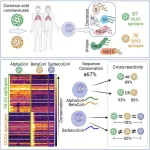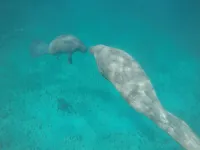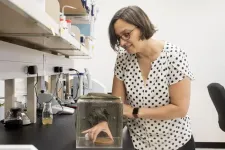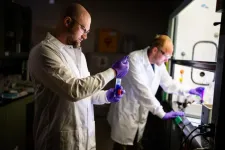(Press-News.org) LA JOLLA, CA—Scientists at La Jolla Institute for Immunology (LJI) are investigating how the immune system's T cells react to a wide variety of coronaviruses, ranging from SARS to common cold coronaviruses. Their goal is to guide the development of vaccines that could halt future pandemic by combatting many types of coronaviruses at once.
"While it was recognized that coronaviruses were potentially dangerous viruses, because of SARSCoV and MERS viruses causing very severe disease in humans, nobody knew that the next pandemic was going to be caused by SARS-CoV-2," says LJI Professor Alessandro Sette, Dr.Biol.Sci. "So the issue now is how can we develop strategies that are broadly applicable to different viral families of concern?"
In their latest collaboration, published in Cell Reports Medicine, Sette and LJI Research Assistant Professor Alba Grifoni, Ph.D., show that T cells can recognize several different viral targets, called "antigens," shared between most coronaviruses, including common cold coronaviruses and SARS-CoV-2. They also looked more in-depth at what fragments of these antigens, called “epitopes,” are recognized and how conserved they are across different coronaviruses.
"This study suggests a way to enhance vaccines so that they have broader activity against many different coronaviruses and variants," says Grifoni.
What coronaviruses have in common
Sette and Grifoni are experts in studying which of the antigens that make up a virus's structure are recognized by T cells down to the epitope level. While viruses with similar protein sequences tend to be closely related, even more distant viruses can have some smaller sequences in common. If sequences are recognized by T cells, this immune response can recognize multiple viruses from the same family, even if the viruses themselves are not as similar.
The body's memory CD4+ "helper" T cells patrol the body for protein sequences belonging to past viral invaders. These T cells help launch the immune system attack against a repeat offender—or any closely related pathogens—they come across. This kind of "cross reactivity" is exactly what scientists want to harness to train immune cells to fight many types of coronaviruses at once.
No one had been exposed to SARS-CoV-2 before 2019. Still, humanity was no stranger to coronaviruses. Some coronaviruses cause common colds, others have been shown to cause severe respiratory disease. Of the two groups of coronaviruses, alpha and beta, scientists have so far found beta coronaviruses to be most likely to have pandemic potential and cause severe disease based on three different outbreaks. The 2002–2003 SARS outbreak, the 2012 MERS outbreak, and more recently SARS-CoV-2, were all caused by beta coronaviruses. Alpha and beta coronaviruses also share similarities in some of the epitopes recognized, and previous research from Sette and Grifoni has demonstrated that T cells against common cold coronaviruses can "cross-react" with SARS-CoV-2.
Taking aim at four viral targets
For the new study, the goal was to see exactly which viral protein sequences or epitopes prompted the strongest reactions from T cells cross reactive across different coronavirus types.
The researchers first comprehensively analyzed T cells collected from 88 patients before the COVID-19 pandemic. These patients had never been exposed to SARS-CoV-2, of course, but they had been exposed to other types of common cold coronaviruses belonging to either the alpha or beta groups. Researchers used these samples to define which viral antigens and which specific epitopes were recognized by T cells.
Then the LJI team, in collaboration with Professor Richard Scheuerman, Ph.D., of the J. Craig Venter Institute, applied a computational approach to predict which epitopes might be the same between different coronaviruses including SARS-CoV-2. This work, led by LJI Postdoctoral Fellow Alison Tarke, Ph.D., revealed 18 coronavirus epitopes highly conserved across multiple coronaviruses, suggesting these epitopes could induce cross-reactive T cells.
The LJI researchers showed that T cells against alpha or beta common cold coronaviruses tend to be cross-reactive across the two different groups. These coronaviruses had a lot of similarities in their epitope sequences, and T cells showed cross-reactivity in 89 percent of tests.
Cross-reactivity declined to 50 percent when the T cells encountered SARS-CoV-2. This means that although SARS-CoV-2 resembles a distant relative of common cold coronaviruses, it still shares protein sequences with members of its family.
Future coronavirus vaccines could leverage a combined approach using antibody target and T cell responses against epitope sequences conserved across the many types of coronaviruses. "The key finding here is that we could potentially develop vaccines that would focus immune responses on these shared sequences, allowing recognition of many different viruses at once," says Grifoni. "While the SARS-CoV-2 Spike protein is the major target for antibodies, T cells can recognize additional antigens that are conserved across different coronaviruses. The combination of the two could be optimal in the design of a panCorona vaccine."
"This work is also exciting because it suggests this is a viable strategy to induce other families of viruses of concern in light of potential future pandemics, such as for example the family of viruses causing influenza, or the ones causing hemorrhagic fevers, or the family of viruses which includes dengue and Zika virus," adds Sette.
Additional authors of the study, "Targets and cross-reactivity of human T cell recognition of Common Cold Coronaviruses," were Yun Zhang, Nils Methot, Tara M. Narowski, Elizabeth Phillips, Simon Mallal, April Frazier, Gilberto Filaci, Daniela Weiskopf, Jennifer M. Dan, Lakshmanane Premkumar and Richard H. Scheuermann.
This study was supported by the National Institutes of Health's National Institute of Allergy and Infectious Diseases (P01 AI168347, Contract No. 75N93019C00065, HHS75N93019C00076) and a PhD student fellowship through the Clinical and Experimental Immunology Course at the University of Genoa, Italy.
DOI: 10.1016/j.xcrm.2023.101088
###
About La Jolla Institute
The La Jolla Institute for Immunology is dedicated to understanding the intricacies and power of the immune system so that we may apply that knowledge to promote human health and prevent a wide range of diseases. Since its founding in 1988 as an independent, nonprofit research organization, the Institute has made numerous advances leading toward its goal: life without disease. Visit lji.org for more information.
END
Family resemblance: How T cells could fight many coronaviruses at once
LJI researchers work to head off future pandemics by uncovering key similarities between SARS-CoV-2 and common cold coronaviruses
2023-06-01
ELSE PRESS RELEASES FROM THIS DATE:
New UNC study quantifies disparity among minority communities exposed to traffic-related air pollution across the U.S.
2023-06-01
Traffic-related air pollution is a pervasive problem across the United States. Vehicle emissions are highest near major roadways with around 19% of the U.S. population living in the vicinity of a major roadway. In more densely populated states, like California, up to 40% live near a major roadway. Exposure to these pollutants, such as fine particulate matter (PM2.5 ) and nitrogen dioxide (NO2), a byproduct of burning fossil fuel, can lead to a host of health effects including premature death. Minority communities often live along these corridors and experience disproportionate exposures.
A ...
Study identifies boat strikes as a growing cause of manatee deaths in Belize
2023-06-01
The endangered Antillean manatee faces a growing threat from boat strikes in Belize, according to a new study that raises concerns about the survival of what had been considered a relatively healthy population.
Belize hosts a population of around 1,000 manatees. With the growth of tourism in recent decades, however, Belize has seen a substantial increase in boat traffic, making boat strikes an increasingly important cause of manatee deaths and injuries.
The new study, published June 1 in Endangered Species Research, used 25 years of data on manatee strandings (dead or injured ...
Biologists to create ‘toolbox’ for understanding complex genetic traits
2023-06-01
Driven by a lifelong curiosity about the natural world and the diversity of life, Elizabeth King, associate professor in the Division of Biological Sciences at the University of Missouri, found inspiration to spend her formative years studying science — and along the way she discovered her passion for biology. That foundation has led her to pursue an ongoing career working to develop a better understanding of genetic traits from a biological perspective.
Recently, the National Institutes of Health (NIH) awarded King a five-year, $1.9 million grant to expand her lab’s research ...
Salton Sea environment detrimental to respiratory health of local children
2023-06-01
RIVERSIDE, Calif. -- In the United States, low-income immigrant and minority children often live in environments that have highly polluted air. A study led by researchers at the University of California, Riverside, demonstrates this among the Latinx and Purépecha immigrant children and caregivers living along Inland Southern California’s Salton Sea, a highly saline drying lakebed surrounded by agricultural fields. The Purépecha community is an Indigenous group from the Mexican state of Michoacán.
“Children of Latinx ...
Fellowship offers reporters valuable insight as America ages
2023-06-01
The Gerontological Society of America (GSA) has received renewed grant support to welcome a new class of reporters for the Journalists in Aging Fellows Program. The 2023 funders to date include Silver Century Foundation, The John A. Hartford Foundation, Archstone Foundation, and NIHCM Foundation.
Since its founding in 2010, this program has been responsible for more than 800 news stories produced by 217 alumni. It has two goals: to educate journalists about issues in aging, better allowing them to spread a new awareness to general-audience, ethnic, and other minority populations; ...
Critical decision-3A clears way toward standard model test
2023-06-01
NEWPORT NEWS, VA – The U.S. Department of Energy has given the greenlight for the MOLLER experiment to begin procurement of key components with its granting of Critical Decision-3A (CD-3A): Approve Long Lead Procurements. The determination allows the MOLLER project at DOE’s Thomas Jefferson National Accelerator Facility to begin spending $9.14 million for long-lead procurements of critical items for which designs are complete.
After imagining what it would look like for 17 years, Krishna Kumar felt chills the first time he saw fully engineered drawings of the MOLLER experiment.
“Seeing the designs on paper gave me pins and needles,” said Kumar, professor of ...
Sandia scientists achieve breakthrough in tackling PFAS contamination
2023-06-01
ALBUQUERQUE, N.M. — A team at Sandia National Laboratories is developing materials to tackle what has become one of the biggest problems in the world: human exposure to a group of chemicals known as PFAS through contaminated water and other products. Sandia is now investing more money to take their research to the next level.
“It’s in the news constantly. It seems every day we hear of another product that is contaminated. We saw sparkling water with PFAS, toilet paper with PFAS, so it’s ...
Better search for the cause of hereditary diseases
2023-06-01
So far, it has not been possible to explain the causes of around half of all rare hereditary diseases. A Munich research team has developed an algorithm that predicts the effects of genetic mutations on RNA formation six times more precisely than previous models. As a result, the genetic causes of rare hereditary diseases and cancer can be identified more precisely.
Variations of genetic sequence occur relatively frequently – on average, one in a thousand nucleotide of a person’s genome is affected. In rare cases, these changes can lead to defective RNAs and hence non-functional proteins. This can lead to dysfunction in individual organs. If a rare disease is suspected, computer-assisted ...
Cross-cultural analysis reveals evolution and persistence of body-based measurement systems
2023-06-01
Body-based units of measure have cognitive and behavioral advantages over standardized measurement systems, according to a new cross-cultural analysis of the use of body-based measurement in more than 180 cultures worldwide, particularly in the design of ergonomic technologies. The findings reveal new insights into body-based measurement as a cultural phenomenon and may help explain the long-term persistence of their use for centuries after the emergence of standardized measurement systems were invented. The ability to measure things plays a central role in how humans understand and interact with the surrounding world and are important drivers in cultural complexity ...
Autonomous realignment and self-healing in multilayer soft electronic devices
2023-06-01
By combining two dynamic polymers, researchers present a new method for achieving autonomous realignment and self-healing in multilayered soft electronic devices and robots, according to a new study. Like human skin, self-healing polymers allow soft electronic and robotic devices to recover autonomously from various forms of damage. Such devices are often multilayered and embedded with conductive or dielectric materials to achieve functional properties while also maintaining the soft mechanical properties of the self-healing ...
LAST 30 PRESS RELEASES:
S-species-stimulated deep reconstruction of ultra-homogeneous CuS nanosheets for efficient HMF electrooxidation
Mechanical and corrosion behavior of additively manufactured NiTi shape memory alloys
New discovery rewrites the rules of antigen presentation
Researchers achieve chain-length control of fatty acid biosynthesis in yeast
Water interactions in molecular sieve catalysis: Framework evolution and reaction modulation
Shark biology breakthrough: Study tracks tiger sharks to Maui mating hub
Mysterious iron ‘bar’ discovered in famous nebula
World-first tool reduces harmful engagement with AI-generated explicit images
Learning about public consensus on climate change does little to boost people’s support for action, study shows
Sylvester Cancer Tip Sheet for January 2026
The Global Ocean Ship-Based Hydrographic Investigations Program (GO-SHIP) receives the Ocean Observing Team Award
Elva Escobar Briones selected for The Oceanography Society Mentoring Award
Why a life-threatening sedative is being prescribed more often for seniors
Findings suggest that certain medications for Type 2 diabetes reduce risk of dementia
UC Riverside scientists win 2025 Buchalter Cosmology Prize
SETI Institute opens call for nominations for the 2026 Tarter Award
Novel theranostic model shows curative potential for gastric and pancreatic tumors
How beige fat keeps blood pressure in check
Fossils reveal ‘latitudinal traps’ that increased extinction risk for marine species
Review: The opportunities and risks of AI in mental health research and care
New map reveals features of Antarctic’s ice-covered landscape
Beige fat promotes healthy vascular function and blood pressure in mice
Chronic low-dose pesticide exposure reduces the life span of wild lake fish, China-based study shows
Tiny earthquakes reveal hidden faults under Northern California
Long-term pesticide exposure accelerates aging and shortens lifespan in fish
Professor Tae-Woo Lee's research group develops groundbreaking perovskite display technology demonstrating the highest efficiency and industry-level operational lifetime
The “broker” family helps tidy up the cell
Ecology: Mummified cheetahs discovery gives hope for species’ Arabic reintroduction
Researchers survey the ADHD coaching boom
Air pollution and cardiac remodeling and function in patients with breast cancer
[Press-News.org] Family resemblance: How T cells could fight many coronaviruses at onceLJI researchers work to head off future pandemics by uncovering key similarities between SARS-CoV-2 and common cold coronaviruses





